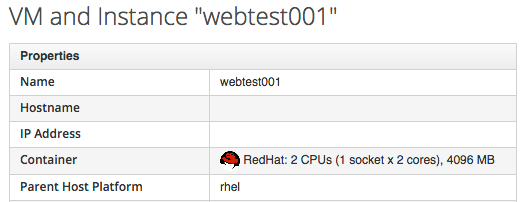Example - Creating a Service Catalog Item
In this section we'll create a Service Catalog Item to provision a VM into RHEV. We'll create a service dialog that allows the user to specify a name for both the new VM and the Service, and specify the number of CPUs and memory size of the provisioned VM from a drop-down list.
The Service Dialog
Finding the Correct Element Names
When we create a service dialog, we need to think carefully what our various element names should be, so that the CatalogItemInitialization State Machine successfully passes the values that we enter to their correct intended destination.
We saw from Catalog{Item,Bundle}Initialization that CatalogItemInitialization recognises and special-cases some element names, including vm_name and service_name, and so we can create two of our elements with these names. If this is all we wish to prompt for, then we can move straight on to creating the service dialog.
For our use-case however, we are also prompting for number of CPUs, and memory size. Any service dialog fields that we create with the intention of altering the final VM configuration (such as number of CPUs, or memory size), must also be named in a particular way. The element name must match the key in the provisioning task's options hash that we wish to overwrite.
We can find this key name in either of 2 ways; by examining the provisioning dialog yaml, or by performing an interactive provision of a VM, and then examining the provisioning task's options hash while the provisioning process is taking place.
Searching the Provisioning Dialog
The simplest way to search the provisioning dialogs is to copy the appropriate one, edit, then select and paste the contents to a flat file that can be grepped, i.e.
grep -i "memory\|cpu\|core\|socket" miq_provision_redhat_dialogs_template.yaml
:number_of_sockets:
:description: Number of Sockets
:cores_per_socket:
:description: Cores per Socket
:vm_memory:
:description: Memory (MB)
This shows that we probably need to name our elements cores_per_socket and vm_memory.
Examining the Options Hash During Provisioning
As an alternative (or confirmation) to finding the key names from the provisioning dialog, we can use one of the techniques that we learnt in Investigative Debugging to dump the contents of the provisioning task's options hash during a normal interactive provision. Here is an example of calling object_walker after the PostProvision stage in the VMProvision_VM/template State Machine:

Using the reader after we've provisioned a VM, we see that the same values are in the miq_provision task's options hash:
~/object_walker_reader.rb | grep 'miq_provision' | grep "memory\|cpu\|core\|socket"
| $evm.root['miq_provision'].options[:cores_per_socket] = [1, "1"] (type: Array)
| $evm.root['miq_provision'].options[:memory_reserve] = nil
| $evm.root['miq_provision'].options[:number_of_sockets] = [1, "1"] (type: Array)
| $evm.root['miq_provision'].options[:vm_memory] = ["1024", "1024"] (type: Array)
Some Commonly Used Element Names
The following table lists some commonly used element names for typical VM characteristics that can be modified from a service dialog:
| VM Characteristic to be Modified | Element Name |
|---|---|
| VM Name | vm_name |
| Number of CPUs | cores_per_socket &/or number_of_sockets |
| VM Memory | vm_memory |
| Root Password | root_password |
| MAC Address (first NIC) | mac_address |
| IP Address (first NIC) | ip_addr |
| OpenStack Flavor | instance_type |
Creating the Service Dialog
We know from the investigation above that we must name our service dialog elements: vm_name, service_name, option_0_cores_per_socket and option_0_vm_memory.
We'll create our service dialog in the same way that we did in A More Advanced Example, but this time we'll create two boxes: Service and VM Names, and VM Characteristics, each containing two elements:
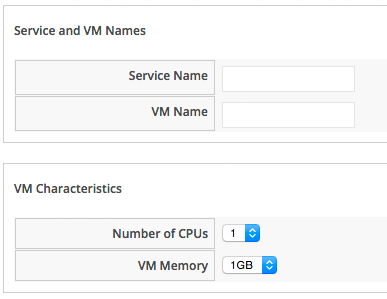
The Service Name and VM Name elements in the first box are both of type Text Box, and have the names service_name and vm_name respectively.
The Number of CPUs element in the second box is of type Drop Down List:
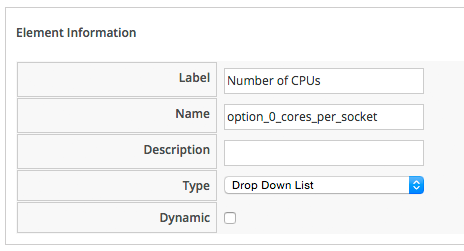
The list is populated as follows:
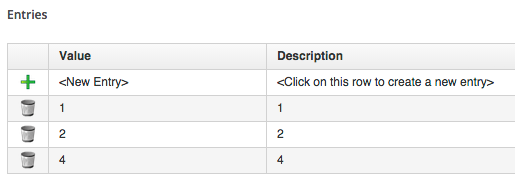
The VM Memory element in the second box is of type Drop Down List:
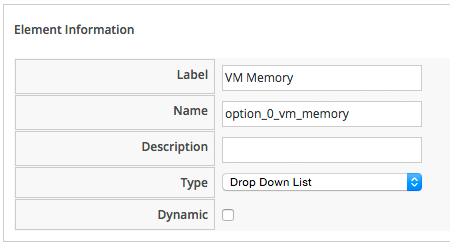
The list is populated as follows:
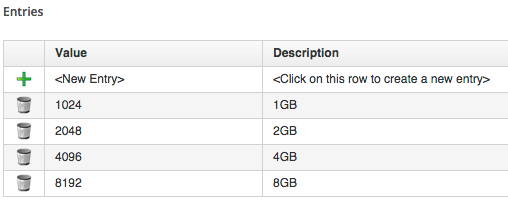
Creating the Service Catalog Item
Create a Catalog
The first thing we should do is create a Catalog to store the service item. We can have many catalogs; they are used to sort our service items and bundles logically.
Navigate to the Catalogs section in the accordion, and select Configuration -> Add a New Catalog:
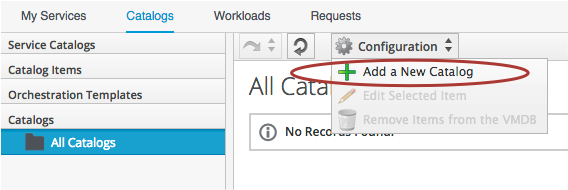
Give the Catalog a name, leave everything else as default, and click Add:
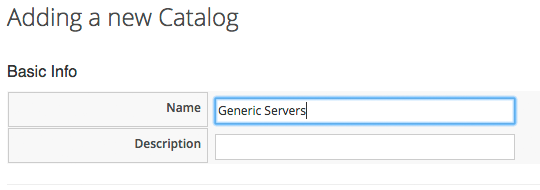
Create the Catalog Item
Navigate to the Catalog Items section in the accordion, highlight the newly created Catalog, then select Configuration -> Add a New Catalog Item:

Select RHEV from the drop-down list:
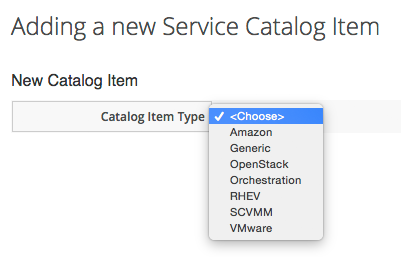
Enter a Name and description:

Tick the Display in Catalog check-box to expose the remaining fields to be filled in. Select our newly created Generic Servers Catalog, and Generic Service Dialog, in the appropriate drop-downs. For the Provisioning Entry Point, navigate to ManageIQ/Service/Provisioning/StateMachines/ServiceProvision_Template/CatalogItemInitialization
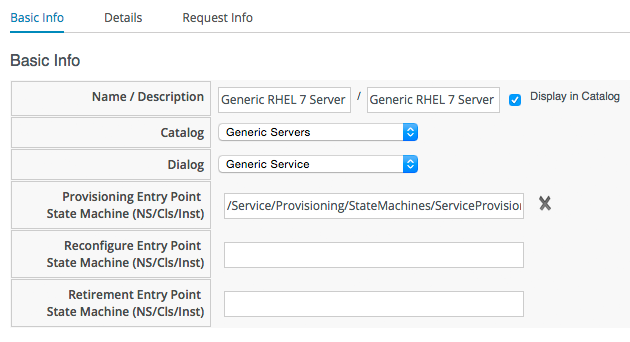
Click on the Details tab, and enter some HTML-formatted text to describe the Catalog Item to anyone viewing in the Catalog:

Click on the Request Info tab, and fill in the details. Select an appropriate template, and Environment, Hardware, Network tab settings that are known to work when a VM is provisioned interactively (see Tips and Tricks). The VM name will be overwritten during the provisioning process, but here we just set it as changeme.
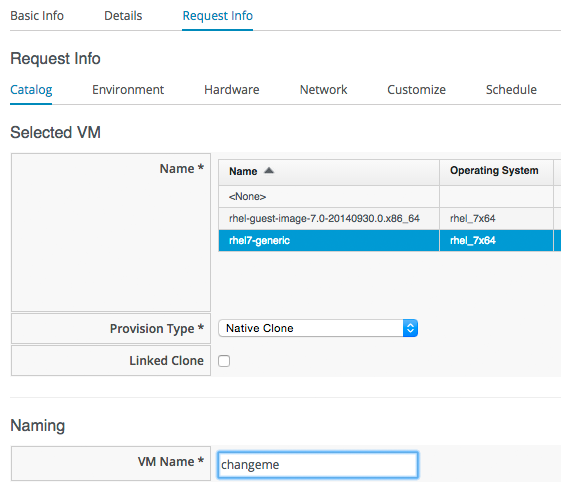
Finally click the Add button.
Select a suitable sized ShadowMan icon for a Custom Image:

Ordering the Catalog Item
Navigate to the Service Catalogs section in the accordion, expand the Generic Servers Catalog, and highlight the Generic RHEL 7 Server Catalog Item
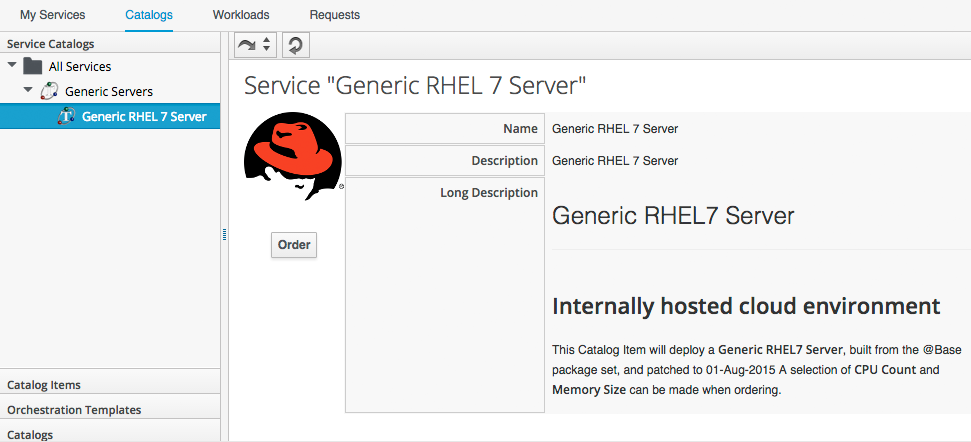
Click Order, and fill out the Service Dialog values:
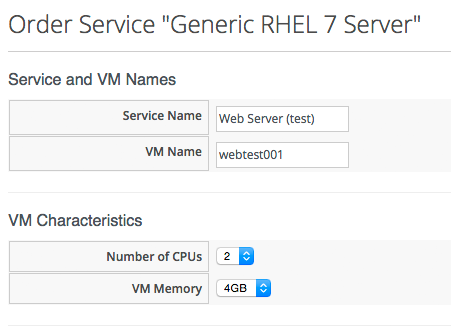
Click Submit
After a few minutes, the new Service should be visible in My Services, containing the new VM:
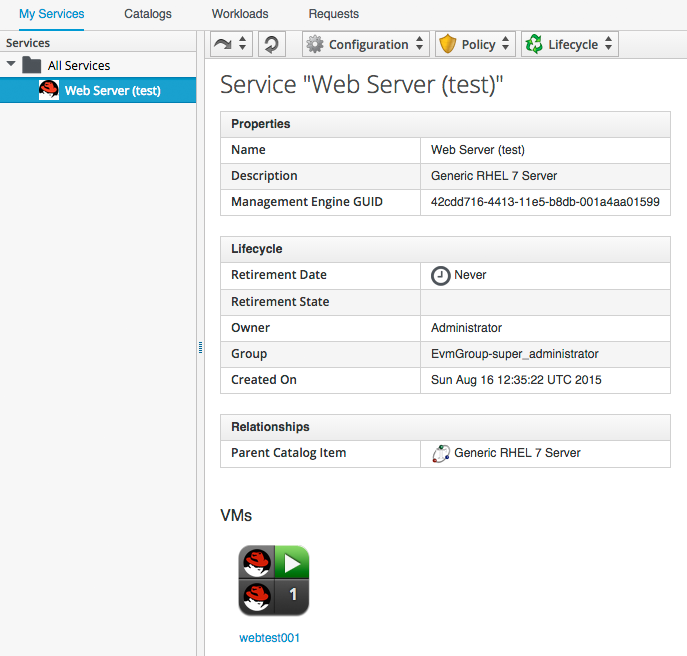
If we examine the details of the VM, we see that it has been created with our requested CPU count and memory size:
